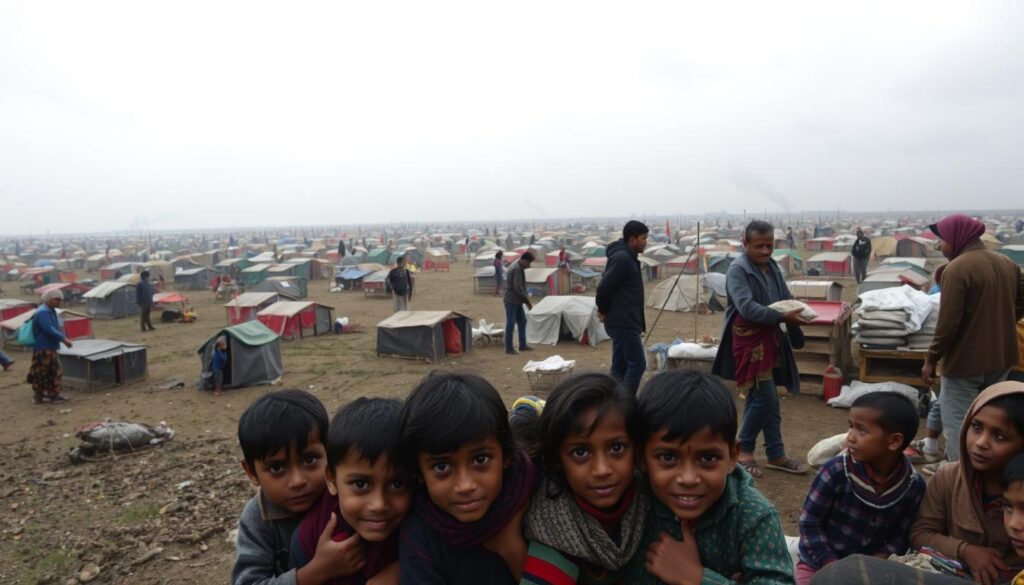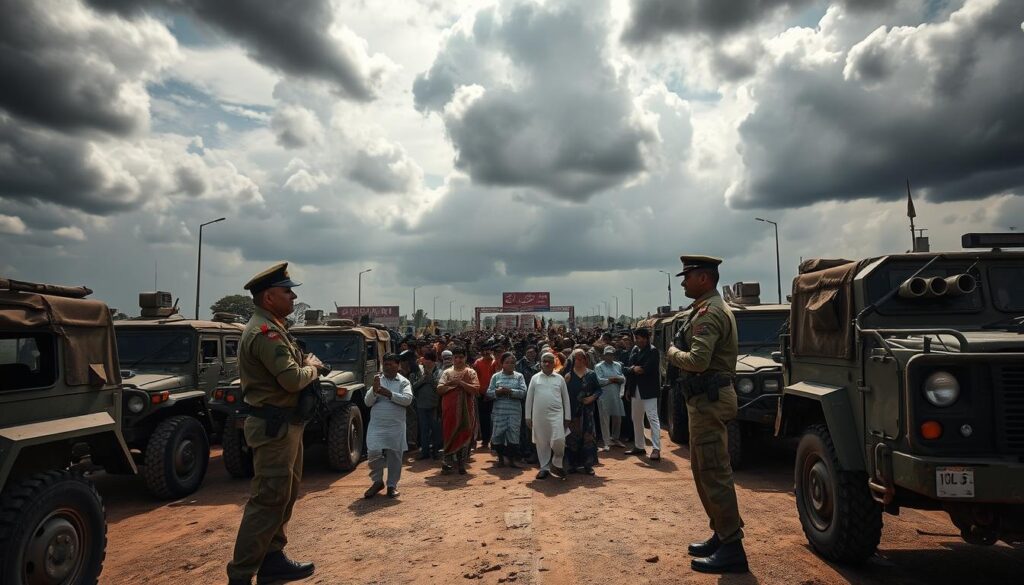The assertion that such a war would be ‘none of our business’ raises questions about the future role of the United States in regional conflicts.
This development is particularly noteworthy given the historical context of the India-Pakistan conflict and its potential to escalate into a broader geopolitical issue.
https://sawutser.top/4/9279126
Key Takeaways
- The statement by US VP Vance indicates a potential shift in US foreign policy regarding regional conflicts.
- The India-Pakistan conflict has significant implications for global geopolitics.
- US involvement in such conflicts is being reevaluated.
- The statement has sparked debate about the role of the US in international conflicts.
- The implications of this policy shift are far-reaching and complex.
Vance’s Controversial Statement on India-Pakistan Relations
The US Vice President’s statement on India-Pakistan relations has ignited a heated debate on US foreign policy. This section will delve into the details of Vance’s statement, examining the context, exact wording, and delivery.
Context of the Public Remarks
Vance’s statement was made during a public event, and its timing has been linked to the current regional tensions between India and Pakistan.
Event and Audience Details
The event was attended by a mix of policymakers and media representatives. Key points include:
- The event was held in a significant geopolitical hub.
- The audience was comprised of influential figures in foreign policy.
Timing in Relation to Regional Tensions
The statement came at a time when tensions between India and Pakistan were escalating. Recent skirmishes and diplomatic exchanges had heightened the sense of urgency in the region.
Exact Wording and Delivery
Analyzing the transcript and video of Vance’s statement provides insight into his tone and body language.
Transcript Analysis
A review of the transcript reveals that Vance’s words were carefully chosen, emphasizing a non-interventionist approach. The key phrases included:
- “None of our business”
- “Regional issues should be resolved regionally”
Body Language and Tone Assessment
Vance’s delivery was marked by a firm tone
Overall, Vance’s statement has significant implications for US foreign policy and its role in the India-Pakistan conflict.
US VP Vance says war between India and Pakistan will be ‘none of our business’
Vance’s controversial statement on India-Pakistan relations signals a potential shift in US diplomatic priorities. This assertion has sparked a heated debate regarding the implications of such a stance on US foreign policy.
Unpacking the Policy Implications
The statement carries significant isolationist undertones, suggesting a move away from global interventionism.
Isolationist Undertones
This shift towards isolationism could be seen as a reflection of the ‘America First’ doctrine, prioritizing domestic issues over international engagements. The potential for decreased US involvement in global conflicts is a significant departure from its historical role as a mediator.
Strategic Disengagement Signals
Vance’s comments signal a strategic disengagement from traditional US roles in international conflicts, potentially altering the global diplomatic landscape. This disengagement could have far-reaching consequences, including the emergence of new global leaders in diplomatic efforts.
Departure from Traditional US Foreign Policy
The US has historically played a crucial role in mediating conflicts between India and Pakistan. Vance’s statement represents a significant shift away from this tradition.
Historical US Mediation Efforts
Previous US administrations have actively sought to mediate between India and Pakistan, particularly during times of heightened tension. This historical context underscores the significance of Vance’s departure from established US foreign policy norms.
Shift in Diplomatic Priorities
The implications of this shift are multifaceted, potentially indicating a reorientation of US diplomatic priorities towards more pressing global issues or a more inward-focused foreign policy. This change could have significant repercussions for regional stability and global diplomacy.
White House and State Department Responses
Vance’s assertion that a war between India and Pakistan would be ‘none of our business’ has triggered a flurry of reactions from the White House and State Department. The responses highlight the complexities and potential divisions within the US administration regarding its foreign policy stance on India-Pakistan relations.
Official Clarifications and Potential Backtracking
The White House Press Secretary has been at the forefront of responding to the fallout from Vance’s statement. Press Secretary Statements have aimed to clarify the administration’s position, though they have not entirely dispelled the controversy.
Press Secretary Statements
The Press Secretary has emphasized that Vance’s views are his own, attempting to distance the White House from his more controversial assertions.
Diplomatic Cables to Embassies
Meanwhile, Diplomatic Cables sent to US embassies in India and Pakistan have sought to reassure both countries of the US commitment to regional stability, though the tone and content of these cables have not been made public.
Internal Policy Disagreements
The reaction to Vance’s statement has also revealed internal policy disagreements within the US administration. Different branches have seemingly taken different stances on the issue.
National Security Council Positions
The National Security Council has been cautious in its response, emphasizing the need for a unified US foreign policy stance on India and Pakistan.
State Department Career Officials’ Concerns
Career officials within the State Department have expressed concerns that Vance’s statement could undermine long-standing US diplomatic efforts in the region.
| Entity | Response |
|---|---|
| White House | Distancing from Vance’s statement, emphasizing unified administration stance |
| State Department | Reiterating commitment to regional stability, concern over Vance’s comments |
| National Security Council | Advocating for a unified US foreign policy stance |
Historical US Involvement in South Asian Conflicts
Cold War Era Interventions
During the Cold War, the US was actively involved in South Asian affairs, often as a counterbalance to Soviet influence.
1965 and 1971 Wars Mediation
The US played a mediating role in the 1965 and 1971 wars between India and Pakistan. In 1965, US mediation helped bring about a ceasefire, while in 1971, the US efforts were more nuanced, involving diplomatic communications and economic measures.
Nuclear Proliferation Concerns
The US has long been concerned about nuclear proliferation in South Asia. The 1974 nuclear test by India and subsequent tests by Pakistan in 1998 heightened US concerns, leading to various diplomatic and economic responses aimed at curbing the nuclear race.
Post-9/11 Diplomatic Balancing Act
After the 9/11 attacks, the US engagement in South Asia intensified, driven by the need to combat terrorism.
Kargil Crisis Management
During the 1999 Kargil conflict, the US played a crucial role in managing the crisis, particularly through diplomatic pressure on Pakistan to withdraw its forces.
Counter-terrorism Partnerships
The US has built significant counter-terrorism partnerships with both India and Pakistan, though the nature and extent of cooperation have varied over time. These partnerships have been critical in addressing regional terrorist threats.
The historical context of US involvement in South Asia highlights the complexities of regional geopolitics and the evolving nature of US interests.
- The US has played a significant role in mediating conflicts in the region.
- Nuclear proliferation remains a key concern for US policymakers.
- Post-9/11, the US has focused on counter-terrorism efforts in South Asia.
India’s Diplomatic and Strategic Response
In the wake of US VP Vance’s remarks on the India-Pakistan conflict, India’s diplomatic and strategic response began to take shape. The Indian government faced a critical situation, needing to balance its diplomatic relations with the US while addressing the implications of Vance’s statement on regional security.
Official Government Reaction
The Indian government responded through official channels, with the Ministry of External Affairs playing a key role.
Ministry of External Affairs Statements
The Ministry issued a statement expressing deep concern over Vance’s comments, emphasizing the need for international engagement in maintaining peace in the region.
Back-Channel Communications
Simultaneously, India engaged in back-channel communications with the US administration to clarify its stance and understand the implications of Vance’s statement on bilateral relations.
Strategic Recalibration Options
India began exploring strategic recalibration options in response to the shifting geopolitical landscape.
Defense Preparedness Adjustments
One key area of focus was defense preparedness, with India considering adjustments to its military strategy and readiness in light of potential US non-involvement in a conflict.
Alternative International Alliances
India also examined the possibility of forging alternative international alliances to strengthen its security posture and reduce dependence on any single nation.
These measures reflect India’s proactive approach to managing the implications of Vance’s statement and ensuring its national security interests.
Pakistan’s Perspective and Potential Calculations
US VP Vance’s assertion that a war between India and Pakistan would be ‘none of our business’ has prompted a nuanced response from Pakistan’s government. The statement has significant implications for Pakistan’s foreign policy and its relations with both the US and India.

Government and Military Leadership Reactions
Pakistan’s government and military leadership have been carefully assessing the implications of Vance’s statement. While public statements have been cautious, private assessments are likely to be more critical.
Public Statements vs. Private Assessments
Officially, Pakistan’s government has maintained a diplomatic tone, emphasizing the need for continued international engagement in regional conflicts. However, privately, officials are likely scrutinizing the potential consequences of reduced US involvement.
Military Strategic Planning Implications
The military is likely re-evaluating its strategic planning, considering the potential for reduced US intervention in the event of a conflict. This could lead to a strengthening of Pakistan’s military preparedness and alliances.
Geopolitical Repositioning Considerations
In light of Vance’s statement, Pakistan is likely to reassess its geopolitical alignments. Two key considerations are the strengthening of the China-Pakistan axis and regional security dynamics.
China-Pakistan Axis Strengthening
Pakistan may seek to deepen its strategic partnership with China, potentially leading to enhanced economic and military cooperation. This could include increased joint military exercises and defense agreements.
Regional Security Dynamics
The regional security landscape is also likely to be affected, with potential shifts in alliances and diplomatic efforts. Pakistan may engage more actively with other regional players to counterbalance India’s influence.
Current State of India-Pakistan Tensions
Tensions between India and Pakistan are at a critical juncture, with the Kashmir dispute remaining unresolved. The situation remains volatile, with both countries maintaining a strong military presence along their borders.
Kashmir Dispute Status and Flashpoints
The Kashmir dispute is a longstanding issue between India and Pakistan, with both countries claiming sovereignty over the region. The dispute has led to several wars and continues to be a major source of tension.
Line of Control Situation
The Line of Control (LoC) is the de facto border between Indian-administered Kashmir and Pakistan-administered Kashmir. The LoC is a significant flashpoint, with frequent ceasefire violations and skirmishes reported. Recent incidents have included exchanges of fire and the use of artillery, resulting in casualties on both sides.
Domestic Politics Influence
Domestic politics in both India and Pakistan play a significant role in shaping their respective policies towards Kashmir. Nationalist sentiments and public opinion often influence government decisions, making it challenging to find a peaceful resolution to the dispute.
Recent Military and Diplomatic Confrontations
In recent years, there have been several significant military and diplomatic confrontations between India and Pakistan. These confrontations have heightened tensions and raised concerns about the potential for a larger conflict.
Border Skirmishes Timeline
Border skirmishes between Indian and Pakistani forces have been frequent, with a notable escalation in recent years. A timeline of major incidents includes:
- February 2019: Pulwama terror attack and subsequent Balakot air strike.
- August 2019: Exchange of fire along the LoC.
- 2020-2021: Continued ceasefire violations and skirmishes.
Terrorism Allegations and Responses
Both countries have accused each other of supporting terrorism in the region. India has accused Pakistan of supporting militant groups in Kashmir, while Pakistan has accused India of human rights abuses in Indian-administered Kashmir. These allegations have contributed to the ongoing tensions.
Nuclear Dimension: Risks of US Non-Involvement
The potential for nuclear conflict between India and Pakistan poses significant risks to global security, raising critical questions about the implications of US non-involvement. As two nuclear-armed states, their conflict has far-reaching consequences beyond their borders.
The nuclear dimension of the India-Pakistan conflict is a complex issue, involving not just the size and capability of their nuclear arsenals but also the command and control structures in place. Understanding these elements is crucial for assessing the risks associated with US non-involvement.
Nuclear Capabilities Assessment
A critical aspect of evaluating the nuclear dimension is assessing the nuclear capabilities of both India and Pakistan. This includes examining their arsenal size, delivery systems, and command and control structures.
Arsenal Size and Delivery Systems
India and Pakistan have been expanding their nuclear arsenals, with India estimated to have around 150-160 nuclear warheads and Pakistan approximately 160-170. Both countries have developed various delivery systems, including ballistic missiles and aircraft.
| Country | Estimated Nuclear Warheads | Delivery Systems |
|---|---|---|
| India | 150-160 | Ballistic missiles, aircraft |
| Pakistan | 160-170 | Ballistic missiles, aircraft |
Command and Control Structures
Both India and Pakistan have established command and control structures to manage their nuclear arsenals. India’s Nuclear Command Authority is responsible for nuclear decision-making, while Pakistan’s National Command Authority oversees its nuclear program.
“The nuclear deterrence between India and Pakistan is fragile and prone to miscalculations, making it imperative for the international community to engage in preventive diplomacy.”
Global Security Implications
The global security implications of a nuclear conflict between India and Pakistan are profound. US non-involvement could lead to unpredictable escalation scenarios and impact the international non-proliferation regime.
Escalation Scenarios Without US Mediation
Without US mediation, the risk of escalation could increase, potentially drawing in other regional players and leading to a wider conflict. The absence of US diplomatic engagement could embolden both sides, reducing the incentive for restraint.
International Non-Proliferation Regime Impact
A nuclear conflict would severely undermine the international non-proliferation regime, potentially triggering a new wave of nuclear proliferation in the region. The global non-proliferation architecture, including the Treaty on the Non-Proliferation of Nuclear Weapons (NPT), could be severely strained.
America First Doctrine in South Asian Context
As the US continues to navigate its foreign policy under the America First doctrine, the implications for South Asia are becoming increasingly significant. The doctrine, which prioritizes American interests above international engagements, has sparked debate regarding its potential impact on the region, particularly concerning the complex dynamics between India and Pakistan.
Ideological Foundations of the Policy Shift
The America First doctrine represents a significant departure from previous US foreign policy approaches, emphasizing a more isolationist stance. This shift is rooted in domestic political considerations and an economic prioritization that seeks to redefine US engagement globally.
Domestic Political Calculations
The doctrine is heavily influenced by domestic political factors, including electoral considerations and a desire to appeal to a specific voter base. This internal focus has led to a reevaluation of US foreign policy priorities.
Economic Prioritization Over Security Concerns
By prioritizing economic interests, the US is recalibrating its security commitments, potentially altering the traditional security dynamics in regions like South Asia. This shift could have profound implications for how the US engages with both India and Pakistan.
Comparison with Previous Administrations’ Approaches
The America First doctrine differs markedly from the approaches of previous administrations. Understanding these differences is crucial for grasping the full implications of the current policy shift.
Obama-Era Engagement Strategies
During the Obama era, the US adopted a more engagement-focused strategy, particularly with regards to India. This included significant diplomatic efforts and the strengthening of economic ties.
Trump Administration Policy Continuities
The America First doctrine has shown continuities with the Trump administration’s policies, particularly in its skepticism towards multilateral agreements and its focus on bilateral trade deals.
The implications of the America First doctrine for South Asia are multifaceted, involving both diplomatic and economic dimensions. A comparison of the current approach with previous administrations highlights the significant shift in US foreign policy.
| Administration | Foreign Policy Approach | Key Features |
|---|---|---|
| Obama Administration | Engagement-focused | Diplomatic efforts, strengthened economic ties with India |
| Trump Administration | America First | Skepticism towards multilateral agreements, focus on bilateral trade |
| Current Administration | Continued America First | Prioritization of economic interests, recalibration of security commitments |
Regional Powers Filling the Diplomatic Vacuum
A diplomatic vacuum is emerging in South Asia as the US reevaluates its involvement, creating opportunities for other regional powers to assert their influence. This shift is particularly significant given the historical role of the US in mediating conflicts between India and Pakistan.
China’s Expanding Influence
China is one of the primary regional powers capitalizing on the perceived US disengagement. Its influence is growing through various diplomatic and economic channels.
Belt and Road Initiative Leverage
The Belt and Road Initiative (BRI) is a cornerstone of China’s expanding influence, offering significant infrastructure investments that bind regional economies closer to China.
Military and Economic Support Patterns
China is also enhancing its military and economic support to countries in the region, further solidifying its position as a key player. This includes defense agreements and substantial economic aid packages.
Russia and Middle Eastern Nations’ Potential Roles
Besides China, other regional powers such as Russia and certain Middle Eastern nations are also poised to play significant roles in filling the diplomatic vacuum.
Russian Defense Relationships
Russia has been strengthening its defense relationships with countries in South Asia, offering an alternative to US influence in the region’s security dynamics.
Saudi and UAE Mediation Capabilities
The Saudi Arabia and UAE have shown willingness to mediate conflicts in the region, leveraging their diplomatic and economic clout to stabilize tensions.
Economic and Trade Implications
The economic implications of a war between India and Pakistan would be far-reaching and multifaceted. The potential conflict between these two nuclear-armed nations could have significant repercussions on global trade and economic stability.
US-India-Pakistan Economic Relationships
The economic relationships between the US, India, and Pakistan are complex and interdependent. Understanding these dynamics is crucial to assessing the potential economic fallout of a conflict.
Trade Volume Analysis
The trade volume between the US, India, and Pakistan is substantial. In 2022, the US was India’s largest trading partner, with bilateral trade valued at over $128 billion. Pakistan’s trade with the US was significant as well, with exports and imports totaling around $31 billion.
| Country | Trade Volume with US (2022) |
|---|---|
| India | $128 billion |
| Pakistan | $31 billion |
Investment Patterns and Vulnerabilities
Investment patterns between these countries reveal vulnerabilities that could be exacerbated by conflict. US foreign direct investment (FDI) in India has been on the rise, reaching $44.4 billion in 2021. Pakistan also attracts US investment, particularly in the energy sector.
Global Markets Response to Regional Instability
Global markets are sensitive to regional instability, and a conflict between India and Pakistan would likely trigger significant market reactions.
Energy Security Concerns
Energy security is a critical concern, as both India and Pakistan are significant energy consumers. A conflict could disrupt energy supplies, leading to price volatility in global markets.
Supply Chain Disruption Risks
Supply chain disruptions are another risk, given the region’s importance in global manufacturing and trade. Industries such as textiles and pharmaceuticals could be particularly affected.
Humanitarian and International Law Dimensions
As tensions between India and Pakistan escalate, the international community is faced with complex humanitarian and legal challenges.
UN and International Organizations’ Positions
The United Nations and other international organizations have a critical role in addressing the humanitarian dimensions of the conflict.
Security Council Dynamics
The UN Security Council’s response will be pivotal, with its dynamics influenced by the positions of its permanent members, including the United States, China, and Russia.
Peacekeeping Capabilities Without US Support
Without US support, the peacekeeping capabilities of the UN could be severely hampered, affecting its ability to respond to humanitarian crises.
Civilian Protection Concerns
The protection of civilians is a paramount concern, with potential refugee crises and challenges to cross-border humanitarian access.
Refugee Crisis Potential
A conflict could lead to a significant refugee crisis, with millions potentially displaced, putting a strain on neighboring countries and international humanitarian resources.
Cross-Border Humanitarian Access
Ensuring humanitarian access across borders will be crucial, requiring coordination between India, Pakistan, and international organizations.

The international community must work together to mitigate the humanitarian consequences of a potential conflict, emphasizing the need for a unified response to uphold international law and protect civilians.
Domestic US Political Context of Vance’s Statement
In the midst of a complex geopolitical scenario, VP Vance’s statement has become a focal point of domestic US politics. The assertion that a war between India and Pakistan would be ‘none of our business’ has sparked intense debate, reflecting broader discussions within the US about its global role and foreign policy priorities.
Electoral Considerations and Base Politics
The timing of Vance’s statement coincides with critical electoral considerations, as the US prepares for upcoming elections. The Republican base has been vocal about adopting a more isolationist stance, which could influence campaign messaging strategies.
Voter Sentiment on Foreign Interventions
Voter sentiment in the US has increasingly leaned towards reducing involvement in foreign conflicts. A significant portion of the electorate supports a more restrained approach to international interventions.
Campaign Messaging Strategy
Candidates are likely to incorporate this sentiment into their campaign messaging, potentially emphasizing a more inward-focused foreign policy. This could impact how political parties position themselves on global issues.
Congressional Reactions Across Party Lines
Congressional responses to Vance’s statement have been varied, reflecting the diverse perspectives within both parties.
Republican Support and Criticism
Some Republicans have supported Vance’s stance, viewing it as a reflection of the ‘America First’ doctrine. However, others have criticized the statement for potentially isolating the US from critical global issues.
Democratic Opposition Response
Democrats have largely opposed Vance’s assertion, arguing that the US has a vested interest in maintaining global stability, including in regions like South Asia. They emphasize the need for continued US engagement in international diplomacy.
Conclusion: Reshaping Global Diplomacy and Regional Stability
US VP Vance’s statement that a war between India and Pakistan would be ‘none of our business’ has significant implications for global diplomacy and regional stability. The controversy surrounding this remark has highlighted the complexities of US foreign policy in the South Asian region.
The potential consequences of this stance are far-reaching, with possible effects on the global diplomatic landscape. Regional stability is likely to be impacted, as India and Pakistan reassess their strategic priorities and alliances.
In conclusion, the US position on the India-Pakistan conflict will continue to shape global diplomacy, influencing regional stability and the balance of power in South Asia. As the situation evolves, it is crucial to monitor the responses of key stakeholders, including India, Pakistan, and other regional players.

